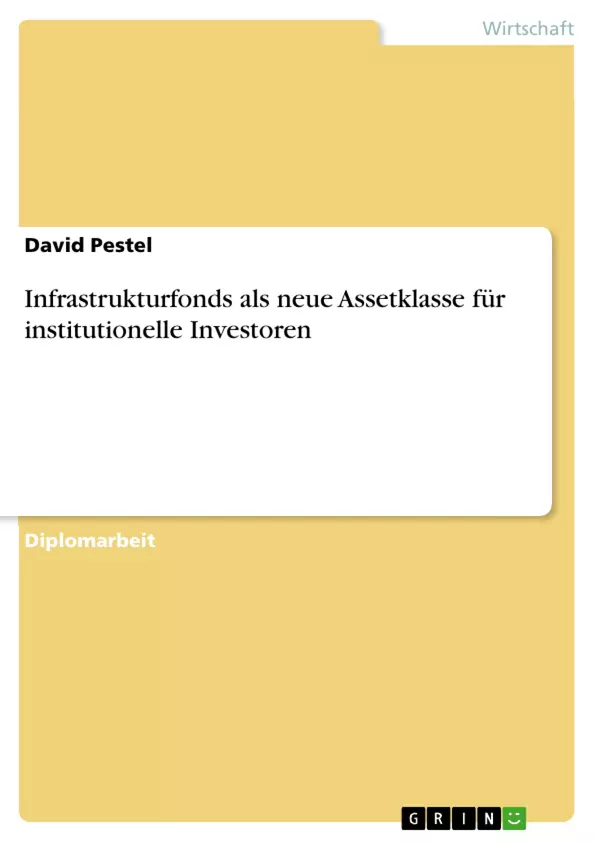Vor dem Hintergrund eines erheblichen Infrastrukturbedarfs sowie eines Mangels an verfügbaren Mitteln der öffentlichen Haushalte, rücken immer mehr Unternehmen, welche mit ihren Leistungen zur Sicherstellung der Grundversorgung maßgeblich beitragen, in den Fokus von privaten Kapitalanlegern. Ausgehend von Australien und UK, die bereits Ende des letzten Jahrhunderts ihren Infrastrukturmarkt für diverse Investoren geöffnet haben, ist auch in Deutschland ein wachsendes Interesse an privat finanzierter Infrastruktur zu beobachten.
Diese Arbeit untersucht die Potenziale von Infrastrukturfonds als Anlagealternative für institutionelle Investoren.
Um Erkenntnisse des Anlagemarktes von Infrastruktur als Assetklasse zu gewin-nen, wird im ersten Abschnitt das gegenwärtige Verständnis des Infrastrukturbegriffs anhand der Fachliteratur analysiert. Hierbei werden wichtige Charakteristika und Produktmerkmale von Infrastruktur aufgezeigt, die für eine Abgrenzung zu traditionellen und alternativen Assetklassen bedeutsam sind. Die soziale und wirtschaftliche Bedeutung von Infrastruktur wird anhand einer Darstellung der weltweiten Bedarfssituation hervorgehoben. Hierbei werden einzelne Wirtschaftsräume eingehend betrachtet.
Im Anschluss wird im Rahmen einer empirischen Studie Infrastruktur als Assetklasse analysiert und deren Eigenständigkeit in Bezug auf Immobilien und PE nachgewiesen. In die Betrachtung fließt die Zielstellung der institutionellen Investoren ebenso wie die spezifischen qualitativen und quantitativen Anforderungen an ein Infrastrukturfondsinvestment ein. Die Ergebnisse bilden die Grundlage für einen „optimalen“ Infrastrukturfonds aus Sicht institutioneller Investoren. Experteninterviews stützen die Ergebnisse der Studie.
Im dritten Abschnitt erfolgt mittels aktuellen börsennotierten (listed) und nicht börsennotierten (unlisted) Investitionsformen eine Abgrenzung der Infrastruk-turfonds zu allgemeinen (Aktien, Zertifikate, Indizes, REITs/Immo-AGs) und
infrastrukturspezifischen (offener/geschlossener Immobilienfonds, Private-Equity-Fonds) Anlagevehikeln. Zudem wird explizit auf die deutschen offenen Infrastrukturfonds (ÖPP-Fonds) eingegangen.
Im Ergebnis der empirischen und theoretischen Erkenntnisse werden im letzten Abschnitt Infrastrukturfonds als Assetklasse definiert. Darüber hinaus werden Investoren Handlungsalternativen aufgezeigt.
Inhaltsverzeichnis (Table of Contents)
- Vorwort
- Empirische Untersuchung
- Auswertung der empirischen Untersuchung Infrastrukturfonds
Zielsetzung und Themenschwerpunkte (Objectives and Key Themes)
Diese Arbeit zielt darauf ab, durch empirische Analysen des Kapitalmarktes Erkenntnisse über den Besitz, die Akzeptanz und Einstellungen zur Finanzanlage "Infrastruktur" zu gewinnen. Ziel ist es, eine Bewertung von Infrastrukturfonds als neue Assetklasse vorzunehmen und die Ergebnisse für Anbieter von Infrastrukturfonds, institutionelle Investoren und die Öffentlichkeit zugänglich zu machen.
- Einordnung des Begriffs der Infrastruktur
- Infrastruktur im Kontext des globalen Kapitalmarktes
- Empirische Analyse des Kapitalmarktes in Bezug auf Infrastrukturfonds
- Struktur der Investitionstätigkeit am Kapitalmarkt
- Definition von Infrastrukturfonds und Handlungsalternativen für institutionelle Investoren
Zusammenfassung der Kapitel (Chapter Summaries)
- Das Vorwort erläutert den Kontext der Arbeit und die Notwendigkeit, Infrastrukturfonds als neue Assetklasse zu untersuchen. Es werden die Ziele der Arbeit, die Methodik und die Einschränkungen der Studie dargelegt.
- Das Kapitel "Empirische Untersuchung" gibt einen kurzen Überblick über die durchgeführte empirische Untersuchung, die sich auf die Analyse von Infrastruktur als Assetklasse konzentriert.
- Das Kapitel "Auswertung der empirischen Untersuchung Infrastrukturfonds" beschreibt die Ergebnisse der empirischen Untersuchung, die mit dem Institut für Immobilienmanagement durchgeführt wurde. Die Auswertung umfasst Ziele von Alternativen Investments, Infrastruktursektoren, qualitative und quantitative Auswahlkriterien und Hindernisse für Infrastrukturinvestments.
Schlüsselwörter (Keywords)
Die Arbeit befasst sich mit dem Thema Infrastrukturfonds als neue Assetklasse für institutionelle Investoren. Die zentralen Schlüsselbegriffe sind Infrastruktur, Infrastrukturfonds, Assetklasse, institutionelle Investoren, Kapitalmarkt, Alternativen Investments, empirische Analyse und empirische Untersuchung.
- Quote paper
- David Pestel (Author), 2008, Infrastrukturfonds als neue Assetklasse für institutionelle Investoren, Munich, GRIN Verlag, https://www.grin.com/document/173856



